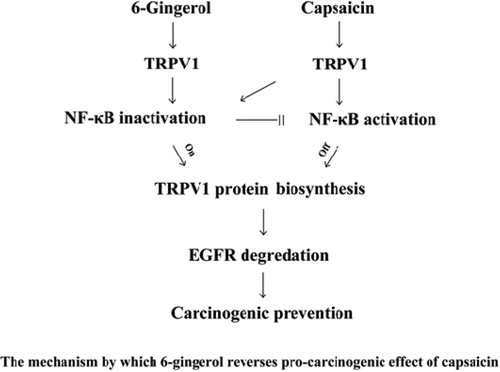Ginger and chili peppers could work together to lower cancer risk

For many people, there's nothing more satisfying than a hot, spicy meal. But some research has suggested that capsaicin, the compound that gives chili peppers their kick, might cause cancer. Now researchers show in mouse studies that the pungent compound in ginger, 6-ginergol, could counteract capsaicin's potentially harmful effects. In combination with the capsaicin, 6-gingerol could lower the risk of cancer, they say. The study appears in ACS' Journal of Agricultural and Food Chemistry.
Both chili peppers and ginger are widely used spices in certain cuisines, particularly in Asia, and have been studied for potential health effects. Although some studies have shown that peppers can have benefits, others suggest that diets rich in capsaicin might be associated with stomach cancer. Ginger, however, has shown promise as a health-promoting ingredient. Oddly enough, capsaicin and 6-gingerol both bind to the same cellular receptor—one that is related to tumor growth. Jiahuan Li, Gangjun Du and colleagues wanted to further investigate this apparent contradiction.
Over several weeks, the researchers fed mice prone to lung cancer either capsaicin or 6-gingerol alone, or a combination of both. During the study period, all of the mice that received only capsaicin developed lung carcinomas while only half of the mice fed 6-gingerol did. Surprisingly, an even lower percentage—only 20 percent—of the mice given both compounds developed cancer. The researchers also dug into the potential molecular underpinnings of how the compounds interact to lead to this effect.
More information: Shengnan Geng et al. Gingerol Reverses the Cancer-Promoting Effect of Capsaicin by Increased TRPV1 Level in a Urethane-Induced Lung Carcinogenic Model, Journal of Agricultural and Food Chemistry (2016). DOI: 10.1021/acs.jafc.6b02480
Abstract
Both gingerol and capsaicin are agonists of TRPV1, which can negatively control tumor progression. This study observed the long-term effects of oral administration of 6-gingerol alone or in combination with capsaicin for 20 weeks in a urethane-induced lung carcinogenic model. We showed that lung carcinoma incidence and multiplicity were 70% and 21.2 ± 3.6, respectively, in the control versus 100% and 35.6 ± 5.2 in the capsaicin group (P < 0.01) and 50% and 10.8 ± 3.1 in the 6-gingerol group (P < 0.01). The combination of 6-gingerol and capsaicin reversed the cancer-promoting effect of capsaicin (carcinoma incidence of 100% versus 20% and multiplicity of 35.6 ± 5.2 versus 4.7 ± 2.3; P < 0.001). The cancer-promoting effect of capsaicin was due to increased epidermal growth-factor receptor (EGFR) level by decreased transient receptor potential vanilloid type-1 (TRPV1) level (P < 0.01) . The capsaicin-decreased EGFR level subsequently reduced levels of nuclear factor-κB (NF-κB) and cyclin D1 that favored enhanced lung epithelial proliferation and epithelial–mesenchymal transition (EMT) during lung carcinogenesis (P < 0.01). In contrast, 6-gingerol promoted TRPV1 level and drastically decreased the levels of EGFR, NF-κB, and cyclin D1 that favored reduced lung epithelial proliferation and EMT (P < 0.01). This study provides valuable information for the long-term consumption of chili-pepper-rich diets to decrease the risk of cancer development.


















